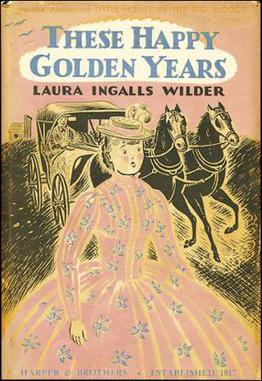These Happy Golden Years facts for kids

Front dust jacket with Sewell's illustration
|
|
| Author | Laura Ingalls Wilder |
|---|---|
| Illustrator | Helen Sewell and Mildred Boyle Garth Williams (1953) |
| Country | United States |
| Series | Little House |
| Genre | Children's novel Family saga Western |
| Publisher | Harper & Brothers |
|
Publication date
|
March 17, 1943 |
| Media type | Print (hardcover) |
| Pages | 299; 288 pp. |
| OCLC | 2145915 |
| LC Class | PZ7.W6461 Th |
| Preceded by | Little Town on the Prairie |
| Followed by | The First Four Years |
These Happy Golden Years is a children's book by Laura Ingalls Wilder. It came out in 1943. This book is the eighth in her famous Little House series. It tells the true story of Laura's teenage years. The story takes place near De Smet, South Dakota. It covers her time as a young teacher and her romance with Almanzo Wilder. The book spans the years from 1882 to 1885, ending with their wedding.
This novel was recognized as a Newbery Honor book in 1944. Several other Little House books also received this award.
Contents
What Happens in the Story
Laura's First Teaching Job
The story begins in the middle of winter. Laura's dad, Pa, takes her 12 miles from home. She is going to her first teaching job. Laura is only 15 years old and still a schoolgirl herself. She feels nervous because it is her first time away from home. It is also her first time teaching a class. But Laura is determined to do well. She wants to earn money for her sister Mary. Mary is attending a college for the blind in Iowa.
The weather is very cold. The small house where Laura stays is hard to heat. The schoolhouse is also very cold. Some of the students Laura teaches are older than her. This makes it hard for her to control the class. Even worse, she lives with the head of the school board. His wife is unhappy and does not like Laura. Laura soon starts to dislike living there. She especially dreads the weekends when she cannot go to school.
Almanzo's Help and Growing Love
To Laura's surprise, Almanzo starts driving to the school. He travels 24 miles each way. This allows Laura to come home on weekends. Her mother, Ma, was a teacher too. Ma gives Laura good advice. Laura learns to be more confident. She successfully finishes her two-month teaching job.
Laura is surprised when Almanzo keeps asking her out. They go sleigh riding even after she returns home. Their relationship grows stronger. Laura sees her friends getting married and leaving school. Sleigh rides turn into buggy rides in the spring. Laura impresses Almanzo by helping him train his new horses. These horses are often wild and difficult.
Laura's Studies and Mary's Return
Laura continues to study hard for her own education. She stays at the top of her classes. She also takes on extra jobs. She teaches another term to earn money for Mary's schooling. Thanks to Laura's extra earnings, the Ingalls family settles on their land. They begin a peaceful and successful life. Mary graduates from college and comes back home.
The Engagement and Wedding
Laura and Almanzo's romance continues to grow. One day, Almanzo offers her an engagement ring. She accepts his proposal to marry the next summer. Laura wonders if she likes his horses more than him. Her feelings are tested when he says he must visit his family in Minnesota. He will not be back until spring. Laura realizes she misses him very much. Life does not feel complete without him. They are briefly reunited on Christmas Eve when he returns to see her.
While in Minnesota, Almanzo told his family about the engagement. His older sister, Eliza Jane, was Laura's former teacher. She plans a big, fancy wedding for them in the spring. But neither Almanzo nor Laura want or can afford such a wedding. To stop Eliza Jane from taking over their plans, Laura agrees to marry that same week. Almanzo quickly finishes building their house. Laura hurries to complete her wedding clothes. They have a quiet, small ceremony. The local pastor marries them. Laura says a sad but loving goodbye to her family. Then she leaves for the little house Almanzo built for them.
Historical Facts
Real People Behind the Story
"Lew Brewster" was not his real name. His real name was Louis Bouchie. He was a distant relative of Mr. Boast. Mr. Boast was a good friend of the Ingalls family. He appears in several of the books. Louis Bouchie and Genevieve Masters were the only two people whose names Wilder changed in her books. This was because Nellie and Louis Bouchie's wife were not very nice people. Laura Ingalls Wilder wanted to respect their privacy.
Today, there is a small town called Carthage, South Dakota. This town is located where Wilder placed the Brewster settlement. It is not clear if Carthage grew from the original Bouchie (Brewster) Settlement.
Nellie Oleson's True Identity
The character Nellie Oleson in this story is a mix of two real people. She is based on Genevieve Masters during the school parts of the book. She is also based on Stella Gilbert during the buggy rides with Laura and Almanzo. Near the end of the book, Laura hears that "Nellie has gone back East." This news refers to Genevieve Masters.

